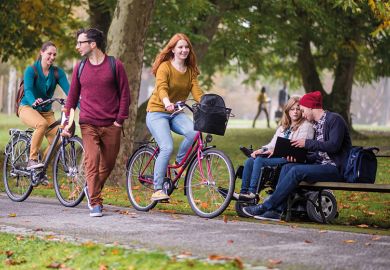All students need to feel included in order to succeed in college. But when a student has a disability, inclusion can be more difficult to achieve. One study shows that students with disabilities participate in fewer extracurricular activities, such as clubs or on-campus events, than their non-disabled peers.
This is due to a lack of social inclusion, the study states. It also stems from the fact that many colleges and university programmes “focus mostly on academic and physical accessibility”.
College students with disabilities are also more likely to drop out of school than their peers without disabilities. Research shows that only 34 per cent of college students with disabilities complete a four-year programme. Conversely, 51 per cent of their peers without disabilities finish school. This begs the question: how can colleges and universities become more inclusive?
Start early
First, teachers at the K-12 level need to develop skills to talk about disabilities. While educators might teach about topics such as race, class, gender or sexuality, disability is often left out of the discussion.
Ask yourself: how many books did you read in school that featured characters with disabilities? How much did you learn about the disability rights movement in your social studies classes?
Disability-based lessons need to be more deliberately incorporated in school. By the time students enter college, they might hesitate to discuss disability because they are worried about saying the wrong thing. Awkwardness and avoidance can continue long after college.
Think about language
When people do talk about disability, they may default to “disability rhetoric” that casts people with disabilities as either inspirational or pitiable.
Ben Myers, an advocate for people with disabilities, explains the problem with disability rhetoric. When you say that a person can do something “despite” his or her disability, it sets up disability as something that strong people overcome and weaker ones live with.
While rhetoric might seem harmless, this kind of speech furthers the idea that people with disabilities are incapable of success.
Inspiration-based language is problematic too. Colleges and universities should examine how disabilities are portrayed in their campus literature. They should also consider using language that reflects the reality of disability. Rather than glorify or pity a person with a disability, talk about them like you would anyone else. Recognise the person and don’t focus on the disability.
Provide opportunities for inclusion
On-campus disability groups can increase disability awareness, promote inclusion and create opportunities for all students to engage in social activities.
At Villanova where I teach, LEVEL – a student-run disability awareness group – provides opportunities for students to raise awareness and participate in fully accessible social activities on and off campus. Similarly, Disability Rights, Education, Activism, and Mentoring (DREAM) is a national organisation in the US that advocates for campus disability groups and individual students.
Make disability a part of diversity
Although many colleges and universities have embraced diversity initiatives, disability still gets short shrift. For instance, in a recent study of the California State University system, researchers found that 66 per cent of websites had minimal information about disabilities on their homepages. The website homepage is the “virtual face” of the university. The authors of the study argue that visible representations of disability are important to make students with disabilities feel “welcome on campus in the same way that images of racial or gender diversity are used to attract diverse applicants”.
In a recent opinion piece, Rosemarie Garland Thomson, a disability justice leader and professor at Emory University, said that most people don’t consider people with disabilities as having a shared social identity or a political status. Given how the disability community has struggled to earn basic civil rights, including access to education, employment and healthcare, it is important to think about disability in terms of diversity.
How disability can be visible and invisible
Recently, there has been a movement to map the accessibility of colleges and universities. At the University of Pennsylvania, a graduate student and his colleagues developed the Accessibility Mapping Project. This project is an effort to digitally map the “emergence of physical and social barriers” around campus. The project shows that a lack of physical access, such as having stairs instead of a ramp, also erects a social barrier, as people with disabilities can’t participate in that space.
And it’s important to remember that disability isn’t only physical. Many college students with invisible disabilities, such as learning difficulties or autism, still struggle to access appropriate accommodations in their university classrooms.
While there is no simple solution to address the exclusion of students with disabilities in higher education, colleges, universities and K-12 schools need to do more to provide resources, education and experiences that include students with disabilities in the conversation.
This blog originally appeared on The Conversation.
Christa Bialka is assistant professor of Special Education at Villanova University.
Register to continue
Why register?
- Registration is free and only takes a moment
- Once registered, you can read 3 articles a month
- Sign up for our newsletter
Subscribe
Or subscribe for unlimited access to:
- Unlimited access to news, views, insights & reviews
- Digital editions
- Digital access to THE’s university and college rankings analysis
Already registered or a current subscriber?


